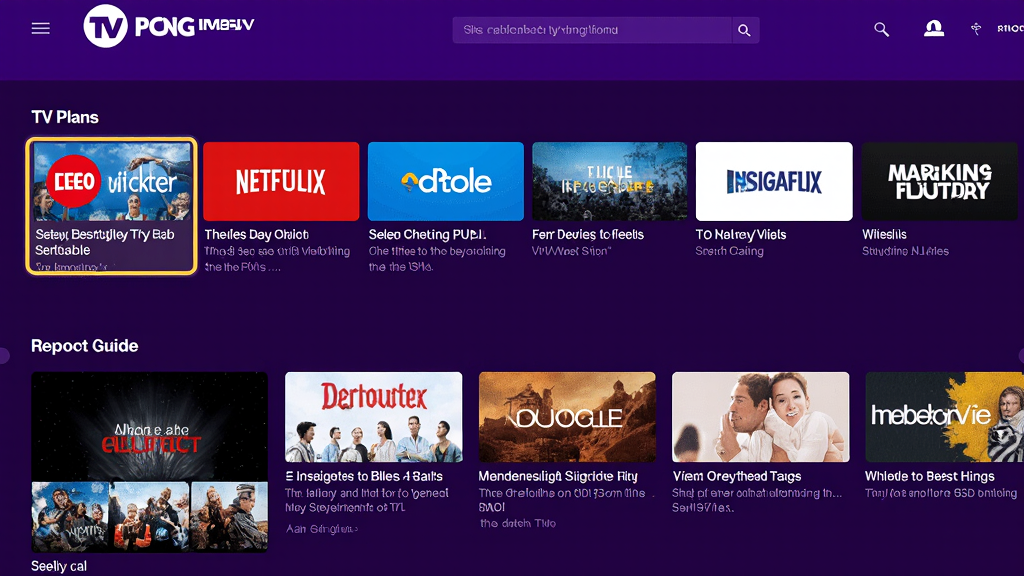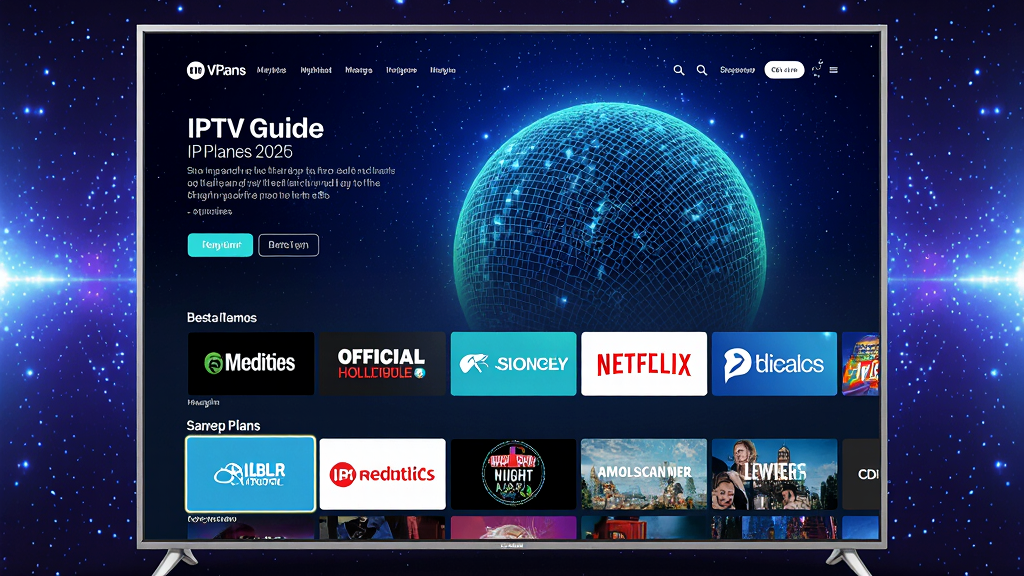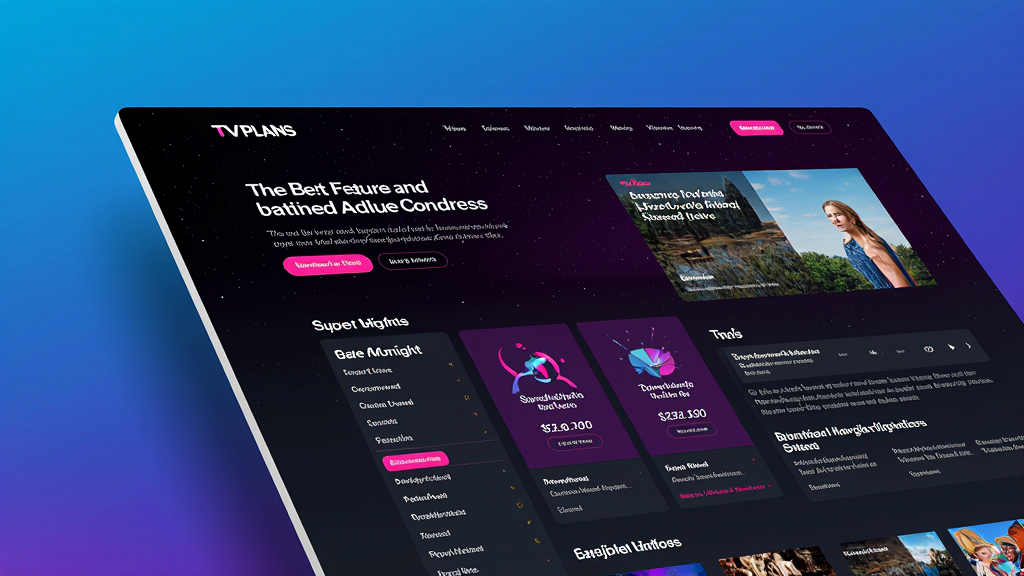Table of Contents
Introduction to tvplans IPTV
In today’s digital age, the way we consume television content has evolved significantly. Gone are the days when people were limited to cable or satellite subscriptions with rigid packages and limited flexibility. Instead, Internet Protocol Television (IPTV) has emerged as a game-changing technology that allows users to access content through the internet with far greater control and variety. Among the different IPTV service providers available, tvplans IPTV has gained recognition for its flexible packages, user-centric design, and broad content catalog.
The concept of IPTV may sound technical at first, but it is essentially the delivery of television services using the internet rather than traditional broadcasting methods. According to TechTarget, IPTV leverages standard internet protocols to transmit video content securely and efficiently, allowing users to stream live TV, movies, and shows with minimal delays. This shift has empowered viewers with more options while also lowering barriers for content providers who want to reach global audiences.
As digital transformation accelerates across industries, IPTV is no longer seen as just an alternative but often as the preferred choice for households and businesses. In this article, we’ll explore tvplans IPTV in depth — its technology, benefits, limitations, and future potential — providing a comprehensive resource for both newcomers and experienced users.

Understanding IPTV Technology
The Difference Between IPTV and Traditional Cable
Traditional cable and satellite TV rely on broadcast technologies that deliver fixed streams of content through coaxial cables or satellites. These streams are often bundled into packages that may not align with user preferences, leading to wasted costs for channels that go unwatched. In contrast, IPTV breaks free from this model by transmitting video signals through broadband internet connections.
With tvplans IPTV, the content is streamed on-demand, enabling users to watch what they want, when they want, and on devices of their choice. For example, a family might watch live sports on their smart TV while children stream cartoons on tablets simultaneously. Unlike cable, which requires specific hardware, IPTV can be accessed with minimal infrastructure, often just a compatible app and a reliable internet connection.
The underlying technology makes IPTV highly scalable and flexible. Unlike broadcasting, where bandwidth is shared among all viewers, IPTV streams are individualized, meaning each user receives a tailored stream that responds to their viewing choices. This customization makes IPTV a perfect fit for today’s on-demand culture.
How Streaming Protocols Work
IPTV relies on streaming protocols such as HTTP Live Streaming (HLS), Real-Time Messaging Protocol (RTMP), and MPEG-DASH. These protocols ensure smooth video delivery by breaking content into smaller chunks and adapting quality dynamically based on available bandwidth. For example, if a user’s connection slows down, adaptive bitrate streaming automatically reduces resolution to avoid buffering, resuming HD quality when bandwidth improves.
The advantage of these protocols is evident in tvplans IPTV, where users often enjoy seamless playback even during peak internet traffic. Additionally, content delivery networks (CDNs) play a crucial role in reducing latency by distributing video streams across geographically closer servers. This ensures that viewers in different regions experience consistent quality regardless of their location.
The Rise of tvplans IPTV in the Global Market
Market Trends and Consumer Adoption
The IPTV market has experienced exponential growth over the last decade. According to Statista, the global IPTV user base has surpassed hundreds of millions, with revenues projected to grow into the tens of billions annually. This growth is fueled by consumer demand for flexibility, personalization, and cost-effectiveness — all qualities embodied by tvplans IPTV.
One key factor driving adoption is the increasing penetration of high-speed internet. With the rollout of fiber-optic networks and 5G, more households can support the bandwidth requirements of IPTV services without compromising quality. Consumers who previously relied on cable are finding IPTV not only more affordable but also more aligned with their digital lifestyles.
Regional Variations and Regulatory Factors
The adoption of IPTV varies significantly across regions. In Europe, IPTV has become a mainstream alternative to cable, while in Asia-Pacific markets, its growth is driven by mobile-first consumption habits. Meanwhile, North America sees strong competition between IPTV and Over-the-Top (OTT) platforms such as Netflix and Hulu.
Regulatory environments also shape the IPTV landscape. Some countries impose strict licensing requirements, while others take a more lenient approach. For providers like tvplans IPTV, compliance with these regulations is essential to ensure legitimacy and avoid piracy concerns.
Types of IPTV Services Available
Live Television
Live television streaming is one of the most popular features of IPTV, allowing users to watch news, sports, and events in real time. With tvplans IPTV, live TV channels are delivered with low latency, ensuring that sports fans don’t miss critical moments.
Video on Demand (VoD)
VoD services allow users to access a library of movies, shows, and documentaries at their convenience. Unlike traditional pay-per-view, VoD offers unlimited playback for a fixed subscription fee. tvplans IPTV integrates VoD seamlessly, often including popular titles alongside niche content not typically available on mainstream platforms.
Time-Shifted Media
Time-shifted media lets users replay or pause live broadcasts. This feature is particularly valuable for viewers in different time zones or those with busy schedules. For example, if a live news broadcast occurs at midnight, a user can replay it the next morning without missing crucial updates.
Benefits of Choosing tvplans IPTV
Cost Efficiency
One of the standout benefits of IPTV is affordability. Traditional cable packages often include dozens of channels users never watch, leading to unnecessary expenses. By contrast, tvplans IPTV offers customizable packages where users pay only for the content they want. This a-la-carte model ensures maximum value for money.
Customization and Flexibility
tvplans IPTV gives viewers complete control over their viewing habits. Users can build personalized playlists, create parental controls, and enjoy tailored recommendations. The service also supports a wide range of devices, including smart TVs, smartphones, tablets, and streaming sticks.
Multi-Device Compatibility
Unlike cable boxes that tie you to a single screen, IPTV enables simultaneous viewing across multiple devices. For families, this means everyone can enjoy their preferred content without arguments over the remote. Additionally, cloud-based synchronization ensures that users can start a movie on one device and continue on another seamlessly.
Challenges and Limitations of IPTV

Bandwidth Requirements
While IPTV offers many advantages, it requires a stable and high-speed internet connection. Users with slower connections may face buffering or degraded video quality. For optimal performance with tvplans IPTV, a minimum of 15–20 Mbps per stream is often recommended.
Legal and Licensing Concerns
Not all IPTV services operate within legal boundaries. Unauthorized providers may stream pirated content, exposing users to risks. According to BBC, law enforcement agencies in several countries have cracked down on illegal IPTV services. Choosing a legitimate provider like tvplans IPTV ensures compliance with copyright laws and safe usage.
Reliability Issues
IPTV services can be affected by outages or server downtimes. Unlike traditional cable, which is less dependent on internet connectivity, IPTV performance can vary during network disruptions. However, reputable providers minimize such risks through redundant infrastructure and CDN optimization.
IPTV vs. OTT Platforms
Key Differences
OTT platforms like Netflix, Amazon Prime, and Disney+ also deliver content over the internet but differ from IPTV in delivery method and scope. OTT services are typically app-based and focus on on-demand content, while IPTV delivers both live and on-demand channels using managed networks.
Which is Better for Consumers?
For users seeking live TV alongside on-demand content, IPTV is often the better choice. OTT platforms excel in curated libraries of movies and series but lack live broadcasting. tvplans IPTV bridges this gap by offering both, making it an attractive all-in-one solution.
Real-World Applications of IPTV
Residential Use Cases
Households use IPTV for entertainment, education, and even fitness. For instance, families can access interactive children’s programs or stream workout classes directly through their IPTV apps.
Corporate and Educational Applications
Businesses leverage IPTV for training, corporate communications, and broadcasting live events internally. Universities integrate IPTV into online classrooms, enabling students to access lectures remotely with interactive features.
Hospitality Industry Integration
Hotels and resorts increasingly adopt IPTV to enhance guest experiences. Guests can access live TV, movies, and personalized recommendations from their rooms, often integrated with hotel services like room service ordering.
Security and Privacy in IPTV Services
Protecting User Data
With IPTV relying heavily on the internet, protecting user data is critical. Providers like tvplans IPTV implement encryption protocols and secure servers to safeguard customer information.
Preventing Piracy and Unauthorized Access
Piracy remains a significant challenge in the IPTV industry. According to Reuters, billions of dollars are lost annually to illegal streaming services. Legal providers invest in digital rights management (DRM) and monitoring systems to ensure their platforms remain secure.
Future of tvplans IPTV
Emerging Technologies
The future of IPTV is closely tied to advancements in 5G, AI, and edge computing. With ultra-fast internet speeds, 5G will eliminate buffering issues, while AI will enable hyper-personalized recommendations for users.
Integration with Smart Homes and AI
As smart homes become more widespread, IPTV services will integrate seamlessly with devices like voice assistants, smart TVs, and home automation systems. Imagine telling your AI assistant to “play tonight’s game” and instantly having it stream in high definition on your living room TV.
How to Choose the Right IPTV Provider

Essential Criteria for Selection
When selecting an IPTV provider, consider factors like content variety, streaming quality, device compatibility, and customer support. Legitimate providers like tvplans IPTV often highlight transparency in pricing and clear licensing agreements.
Common Red Flags to Watch For
Be cautious of providers offering extremely low prices or too-good-to-be-true promises. Poor website design, lack of customer support, and absence of trial periods are red flags. Always research reviews before committing to a subscription.
Conclusion
IPTV is revolutionizing the way people access television content, offering unmatched flexibility, affordability, and personalization. Among the leading options, tvplans IPTV stands out for its comprehensive features and consumer-first approach. As the global appetite for on-demand content grows, IPTV will only become more integral to everyday entertainment, education, and business. For consumers, understanding the technology, benefits, and challenges is key to making informed choices. Whether you are looking for live TV, on-demand movies, or interactive experiences, IPTV has a solution tailored to your needs.

6 Responses